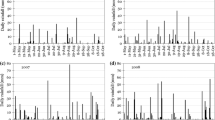Abstract
A field study was conducted at North Platte, Nebraska in 2007–2009, imposing eight irrigation treatments, ranging from dryland to fully irrigated. Four of the eight treatments allowed for various degrees of water stress only after tasseling and silking. In 2007, corn yield ranged from 8.9 Mg ha−1 with a season total of 41 mm of irrigation water to 11.5 Mg ha−1 for the fully irrigated treatment (264 mm of irrigation water). The treatment with the greatest reduction in irrigation water after tasseling and silking (158 mm) had a mean yield of 10.9 Mg ha−1, only 0.6 Mg ha−1 less than the fully irrigated treatment. In 2009, yields ranged from 12.6 to 13.5 Mg ha−1. There were no significant yield differences between the irrigation treatments for several possible reasons: more in-season precipitation and cooler weather required less irrigation water; much of the irrigation water was applied after the most water-stress sensitive stages of tasseling and silking; and lower atmospheric demand allowed for soil water contents well below 50 % management allowed depletion (MAD) not to cause any yield losses.






Similar content being viewed by others
References
Allen RG, Pereira LS, Raes D, Smith M (1998) Crop evapotranspiration—guidelines for computing crop water requirements. Irrigation and drainage paper 56. Food and Agriculture Organization of the United Nations (FAO), Rome
Camp CR (1998) Subsurface drip irrigation: a review. Trans ASAE 41(5):1353–1367
Colaizzi PD, Schneider AD, Evett SR, Howell TA (2004) Comparison of SDI, LEPA, and spray irrigation performance for grain sorghum. Trans ASAE 47(5):1477–1492
Denmead OT, Shaw RH (1962) Availability of soil water to plants as affected by soil moisture content and meteorological conditions. Agron J 54:385–390
Evett SR, Steiner JL (1995) Precision of neutron scattering and capacitance type soil water content gauges from field calibration. Soil Sci Soc Am J 59:961–968
Grassini P, Yang H, Irmak S, Thorburn J, Burr C, Cassman KG (2011) High-yield irrigated maize in the Western U.S. Corn Belt: II. Irrigation management and crop water productivity. Field Crop Res 120:133–141
Howell TA, Schneider AD, Evett SR (1997) Subsurface and surface microirrigation of corn—Southern High Plains. Trans ASAE 40(3):635–641
Klocke NL, Watts DG, Schneekloth JP, Davison DR, Todd RW, Parkhurst AM (1999) Nitrate leaching in irrigated corn and soybean in a semi-arid climate. Trans ASAE 42(6):1621–1630
Klocke NL, Currie RS, Aiken RM (2009) Soil water evaporation and crop residues. Trans ASABE 52(1):103–110
Lamm FR, Camp CR (2007) Subsurface drip irrigation. In: Lamm FR, Ayars JE, Nakayama FS (eds) Microirrigation for crop production—design, operation and management. Elsevier, Amsterdam, pp 473–551
Lamm FR, Trooien TP (2001) Irrigation capacity and plant population effects on corn production using SDI. In: Proceedings of the irrigation association international irrigation technical conference, Nov 4–6, 2001, San Antonio, TX. Available from Irrigation Association, Falls Church VA, pp 73–80
Lamm FR, Manges HL, Stone LR, Khan AH, Rogers DH (1995) Water requirement of subsurface drip-irrigated corn in northwest Kansas. Trans ASAE 38(2):441–448
Lamm FR, Rogers DH, Alam M, O’Brien DM, Trooien TP (2011) Twenty-two years of SDI research in Kansas. In: Proceedings of the 23rd annual central plains irrigation conference, Burlington, Colorado, Feb 23–24, 2011. Available from CPIA, 760 N. Thompson, Colby, KS, pp 68–92
McGuire VL (2004) Water level changes in the high plains aquifer, predevelopment to 2002, 1980–2002, and 2001–2002. Fact Sheet 2004–3026. U.S. Geological Survey, Lincoln, NE
McGuire VL, Fischer BC (1999) Water level changes, 1980–1997 and saturated thickness, 1996–1997, in the High Plains Aquifer. Fact Sheet 124-99. U.S. Geological Survey, Lincoln, Nebraska
Nielsen DC, Unger PW, Miller PR (2005) Efficient water use in dryland cropping systems in the Great Plains. Agron J 97:364–372
Orfanus T, Eitzinger J (2010) Factors influencing the occurrence of water stress at field scale. Ecohydrology 3:478–486
Payero JO, Melvin SR, Irmak S (2005) Response of soybean to deficit irrigation in the semi-arid environment of west-central Nebraska. Trans ASABE 48(6):2189–2203
Payero JO, Klocke NL, Schneekloth JP, Davison DR (2006a) Comparison of irrigation strategies for surface-irrigated corn in West Central Nebraska. Irrig Sci 24(4):257–265
Payero JO, Melvin SR, Irmak S, Tarkalson D (2006b) Yield response of corn to deficit irrigation in a semiarid climate. Agric Water Manag 84:101–112
Payero JO, Tarkalson DD, Irmak S, Davison DR, Petersen JL (2008) Effect of irrigation amounts applied with subsurface drip irrigation on corn evapotranspiration, yield, water use efficiency, and dry matter production in a semiarid climate. Agric Water Manag 95:895–908
Payero JO, Tarkalson DD, Irmak S, Davison DR, Petersen JL (2009) Effect of timing of a deficit-irrigation allocation on corn evapotranspiration, yield, water use efficiency and dry mass. Agric Water Manag 96:1387–1397
Schneekloth JP, Klocke NL, Davison DR, Payero JO (2006) Furrow irrigation management with limited water. Appl Eng Agric 22:391–398
Steiner JL (1989) Tillage and residue effects on evaporation from soils. Soil Sci Soc Am J 53:911–916
Todd RW, Klocke NL, Hergert GW, Parkhurst AM (1991) Evaporation from soil influenced by crop shading, crop residue, and wetting regime. Trans ASAE 34:461–466
USDA (1978) Soil survey of Lincoln County, Nebraska. A publication of the U.S. Department of Agriculture Soil Conservation Service, in cooperation with University of Nebraska Conservation and Survey Division
van Donk SJ, Tollner EW, Steiner JL, Evett SR (2004) Soil temperature under a dormant bermudagrass mulch: Simulation and measurement. Trans ASAE 47:91–98
van Donk SJ, Martin DL, Irmak S, Melvin SR, Petersen JL, Davison DR (2010) Crop residue cover effects on evaporation, soil water content, and yield of deficit-irrigated corn in west-central Nebraska. Trans ASABE 53(6):1787–1797
Acknowledgments
The authors would like to acknowledge the assistance provided by Eugene Richter during the field study.
Author information
Authors and Affiliations
Corresponding author
Additional information
Communicated by K. Stone.
A contribution of the University of Nebraska Agricultural Research Division, supported in part by funds provided through the Hatch Act.
Rights and permissions
About this article
Cite this article
van Donk, S.J., Petersen, J.L. & Davison, D.R. Effect of amount and timing of subsurface drip irrigation on corn yield. Irrig Sci 31, 599–609 (2013). https://doi.org/10.1007/s00271-012-0334-4
Received:
Accepted:
Published:
Issue Date:
DOI: https://doi.org/10.1007/s00271-012-0334-4




